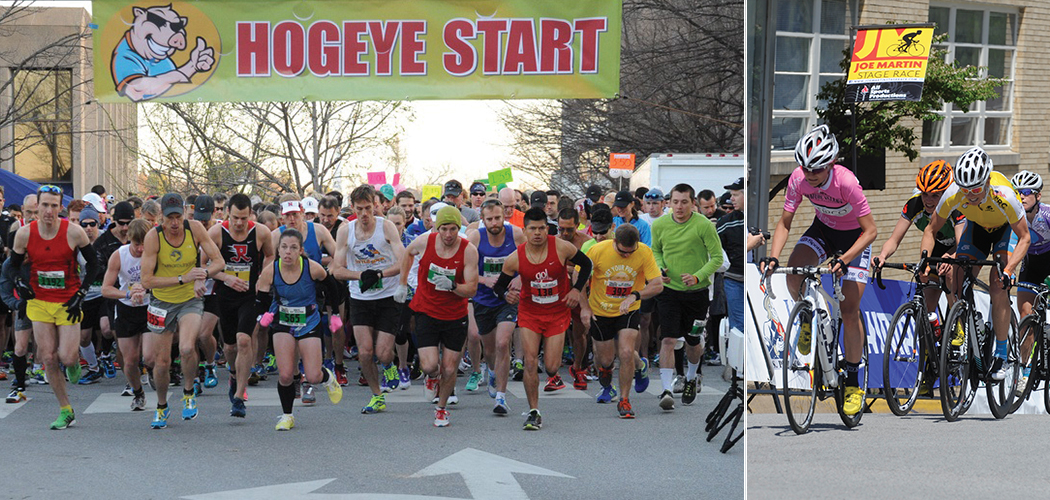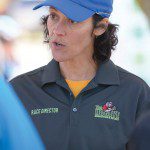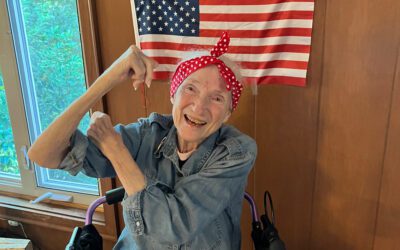[title subtitle=”words: Don Lowe
Images:courtesy Hogeye Marathon Joe Martin Stage Races: courtesy Tom Ewart with NWA Photo”][/title]
Fayetteville, Arkansas comes alive in the spring. Daffodils appear and the trees are full and green. Runners and cyclists, dressed in bold colors, show up all across town. Many of them are in training, getting ready for events like the 40th Annual Hogeye Marathon on April 10, and the 39th annual Joe Martin Stage Race, that begins on April 21 and ends three days later on April 24.
The Hogeye Marathon Race Director Tabby Holmes has been getting ready, both by planning and training, for months now. She foresees a potential record turnout of participants with as many as 2,500 total runners tackling this 26.2-mile course.
In preparing for a marathon, Tabby thinks two important keys are setting a goal to run the race and having a good support system to complete the training. “This includes immersing myself in the culture of running races,” Tabby says. “I do lots of other events, even group, long training runs. There is a social aspect as well as a competition within myself to improve or even just to keep adding on the miles each week. The training is the most important part of the process.”
Tabby believes there has to be muscle memory, along with emotional and psychological memory of what it feels like to be sore, and to push through the furthest training run and beyond. “Everyone is on a different path to the same goal,” she says.
The race starts at Fayetteville’s downtown square and proceeds past The Walton Arts Center on Dickson Street, which is in the heart of the entertainment district. And, from there, runners will trek through the main street of the University of Arkansas campus, Maple Avenue.
“Maple Avenue is one of the most challenging sections because the campus is fairly hilly,” Tabby says. “But, at least it’s in the first two miles of the course and not the last two miles.” Runners then venture through some established neighborhoods where residents will cheer them along.
The course then changes directions, first going east and then north, through the section known as uptown Fayetteville. Runners will then be heading toward Lake Fayetteville, a place Tabby says is the most beautiful, peaceful section of the course. It’s about five miles of rolling, and sometimes challenging, hills.
After that, the scenic course takes runners by Veteran’s Park twice and makes a loop through another established neighborhood with four churches and a school.
Finally, it’s the four-mile home stretch along Mud Creek and Scull Creek trails, before reaching the finish line at Wilson Park. Tabby says that here runners are likely to see ducks, birds, squirrels and chipmunks scampering about, which is an added perk.
In the Joe Martin Stage Race, Race Director Bruce Dunn anticipates more than 700 athletes, with teams from twenty-three countries and all fifty states. It features a time trial of 2.5 miles at Devil’s Den State Park in Winslow, as well as road races taking place in Fayetteville, Prairie Grove and surrounding areas with distances of forty to 110 miles and a final day criterium.
As an avid biker, as well as a USA Triathlon-certified race director, Arkansas State Representative to USA Cycling, and President of the Arkansas Bicycle Coalition, Bruce says that training varies by category. As an example, beginners put in five to seven hours a week. As competition increases, however, cyclists train ten months out of the year with varying degrees of intensity.
“A professional rider will put in five to seven hours a day, six days a week in the off season and ride 12,000 to 15,000 miles per year,” Bruce says. “Bike racing is very unique. It has both physical and mental requirements.” He calls it physical chess and says just being a strong rider is not enough, especially as you progress in categories.
As a cyclist who competes in several races throughout the year, Bruce knows the chall-enges riders are up against. The three phases consist of long-distance treks, as well as the short, individual-effort timed rides and criterium, or ‘crit’ as it is also known, that includes multiple fast-paced laps on closed city streets.
It’s the final day that gets fans stoked as the rapidly-moving riders try to conquer the ‘crit’ course, that features a major climb on each lap and eight total turns, which is double the normal number in one of these events. “The ‘crit’ is very spectator friendly and people can see the pack of riders coming around the course multiple times,” Bruce says. “It’s very exciting to witness 100 bikes tightly grouped, rolling by at thirty-five mph around a corner.”
The race started as the Fayetteville Spring Classic in 1978 under the guidance of Joe Martin, who was passionate about cycling and served as race director until 1988 when he was stricken with cancer. In 1989, the race was renamed in Joe’s honor. A little more than a decade later in 2003, Dunn’s All Sports Productions, Inc., the sports event management company Bruce created, began promoting the race. Bruce says, “We added both a professional men’s and women’s category and placed those races on the national pro cycling tour.”
This marks the thirty-ninth anniversary of the amateur races, the fourteenth anniversary as part of the National Race Calendar and the second year on the Union Cycliste Internationale America Tour calendar.
It’s a big deal nationally because the National Race Calendar is connected to USA Cycling and the UCI America Tour. USA Cycling is the national governing body of cycling and operates under the United States Olympic Committee. Further up the ladder, the UCI is the world governing body for the sport of cycling that’s recognized by the International Olympic Committee.
The national and international connections are incredible. But Bruce loves this event because of how much the local community embraces the racers and the staff. And he’s thankful for so many volunteers showing up, sponsors signing on, and the organizers marveling at how much support they have.
Tabby has the same appreciation that comes from working with the marathon. For her, it’s all about the volunteers, as well as keeping true to the original mission of promoting health and fitness, and giving back to local charities and causes.
Beneficiaries of the Hogeye Marathon include Meals on Wheels, Alzheimer’s Association, Jackson Graves Foundation, Kendrick Fincher Foundation, the American Wheelchair Mission and the new Arkansas Children’s Hospital Northwest. “We have given these and other charities almost $100,000 just in the last two years,” Tabby says.
These are two huge events that put a spotlight on Northwest Arkansas. Having excellent leaders
like Bruce, Tabby, and countless others, involved time and time again helps to ensure these events will shine bright for years to come.
Hogeye Marathon – April 10
hogeyemarathon.com
Joe Martin Stage Race – April 21-24
joemartinstagerace.com
















